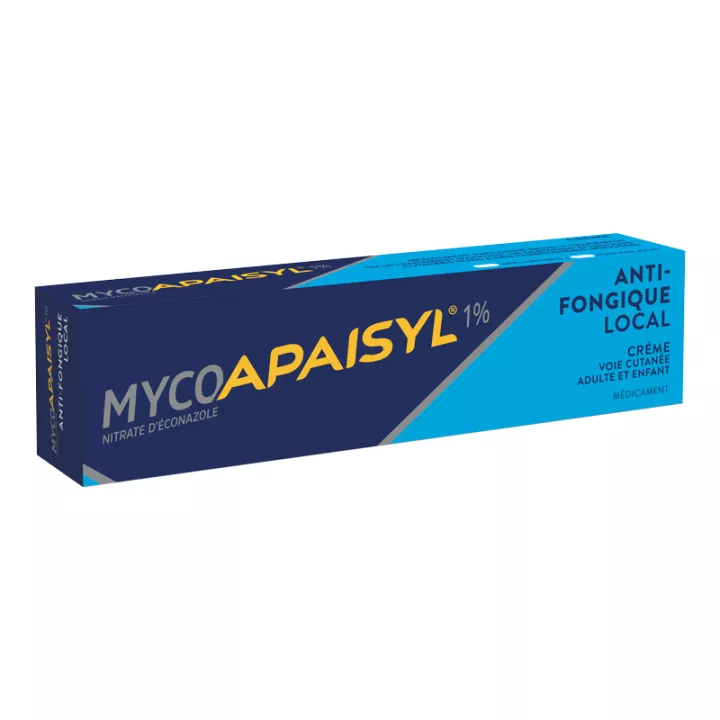NOTICE
ANSM - Updated on: 28/04/2015
Name of the medicinal product
MYCOHYDRALIN cream
clotrimazole
framed
Read this leaflet carefully before you start using this medicine. It contains important information for your treatment.
If you have any further questions, ask your doctor or pharmacist.
· Keep this leaflet, you may need to read it again.
· If you need more information and advice, ask your pharmacist.
· If symptoms worsen or persist, consult a physician.
· If you notice any side effects not listed in this leaflet, or if you experience any of the effects listed as serious, please tell your doctor or pharmacist.
Review summary
In this notice :
1. What is MYCOHYDRALIN, cream and in which cases is it used?
2. What should be known before using MYCOHYDRALIN, cream ?
3. How to use MYCOHYDRALIN, cream?
4. What are the possible side effects?
5. How to store MYCOHYDRALIN, cream?
6. Additional information.
1. WHAT IS MYCOHYDRALIN, cream AND WHAT IT IS USED FOR?
Pharmacotherapeutic group
LOCAL ANTIFUNG
(G: Genitourinary system and sex hormones)
Therapeutic indications
This medication is indicated for the treatment of vulvar infections of vulvo-vaginal mycoses with sensitive yeasts (diseases due to microscopic fungi).
This medication is for adults only.
2. WHAT ARE THE INFORMATION TO BE KNOWN BEFORE USING MYCOHYDRALIN, cream?
List of information needed before taking the medication
Not applicable.
Cons-indications
Never use MYCOHYDRALIN, cream in the following cases:
· Allergy (hypersensitivity) to imidazol derivatives or any of the other ingredients mentioned in "Additional Information".
Precautions for use; special warnings
Warnings and Precautions
Take special care with MYCOHYDRALIN cream :
· Avoid application near eyes.
· In case of application to an injured skin, it is imperative that you observe the recommendations and the dosage indicated by your doctor due to the penetration of the product under these circumstances.
· If you experience any of the following symptoms, before or during the use of MYCOHYDRALIN, please seek advice from your doctor:
o fever, nausea, vomiting,
o low abdominal pain,
o pain in the back or shoulders,
o vaginal secretions accompanied by bad odors,
o vaginal haemorrhage.
· In case of candidiasis, it is advised not to use a soap with acid pH (pH favoring the multiplication of Candida).
· Vaginal douches should be avoided.
· The use of internal buffers, spermicides, condoms or diaphragms should be avoided during treatment with MYCHOHYDRALIN (risk of rupture of the condom or diaphragm)
· It is recommended to avoid sexual intercourse in case of vaginal vulvar mycosis in order to reduce the risk of infection of the partner
· Your doctor may also treat your sexual partner to avoid recontamination
· Treatment may result in local burning sensations and increased itching. Generally, these phenomena yield spontaneously to the continuation of the treatment. If symptoms persist beyond 24 to 48 hours, consult your doctor.
· This medicinal product contains cetostearyl alcohol and may cause local skin reactions (eg eczema).
Interaction with other medicines
Taking or using other medicines:
Please tell your doctor or pharmacist if you are taking or have recently taken any other medicines, even medicines obtained without a prescription.
Interactions with food and beverages
Not applicable.
Interactions with Herbal Medicines or Alternative Therapies
Not applicable.
Use during pregnancy and lactation
Pregnancy
Use of this medication is possible during pregnancy. However, as a precautionary measure, it is best to avoid using the product during the first trimester of pregnancy.
Ask your doctor or pharmacist for advice before taking any medicine.
feeding
It is possible that clotrimazole passes into breast milk. As a precaution, breast-feeding should be discontinued for the duration of treatment.
Ask your doctor or pharmacist for advice before taking any medicine.
Sport
Not applicable.
Effects on ability to drive or use machines
Not applicable.
List of excipients with known effect
Important information about some of the ingredients of MYCOHYDRALIN, cream:
This medicine contains stearyl alcohol.
3. HOW TO USE MYCOHYDRALIN, cream?
Instructions for proper use
Not applicable.
Dosage, Mode and / or route (s) of administration, Frequency of administration and Duration of treatment
Method and route of administration
Do not swallow.
The product should be used twice a day after careful washing and drying of the lesions to be treated.
Duration of treatment
The duration of the treatment is 1 week.
Regular use of the product throughout the course of treatment is critical to successful treatment.
If symptoms persist beyond 7 days, a medical consultation should be considered.
Symptoms and Instructions for Overdose
Not applicable.
Instructions for omission of one or more doses
Not applicable.
Risk of withdrawal syndrome
Not applicable.
4. WHAT ARE POSSIBLE SIDE EFFECTS?
Description of adverse reactions
Like all medicines, MYCOHYDRALIN cream is likely to have side effects, although not everyone is subject to it:
· Urticaria, rash, pruritus, irritations, burns, edema;
· Syncope, hypotension, dyspnea;
· Discomfort at the genital level.
Declaration of side effects
If you experience any side effects, talk to your doctor or pharmacist. This also applies to any side effects not mentioned in this leaflet. You can also report adverse reactions directly through the national reporting system : National Agency for the Safety of Medicines and Health Products (Ansm) and network of Regional Centers of Pharmacovigilance.r . By reporting adverse reactions, you are helping to provide more information about the safety of the drug.
5. HOW TO STORE MYCOHYDRALIN, cream?
Keep this medicine out of the reach and sight of children.
Expiration date
Do not use after the expiry date stated on the outer packaging.
Storage conditions
No special requirements.
If necessary, warnings against visible signs of deterioration
Medicines should not be disposed of via wastewater or household waste. Ask your pharmacist what to do with unused medications. These measures will help protect the environment.
6. ADDITIONAL INFORMATION
Full list of active substances and excipients
What contains MYCOHYDRALIN , cream ?
The active substance is:
Clotrimazole ................................................. .................................................. ..................................... 1.0 g
For 100 g of cream.
The other components are:
Sorbitan stearate, polysorbate 60, cetyl palmitate, cetostearyl alcohol, octyldodecanol, benzyl alcohol, purified water.
Pharmaceutical form and content
What is MYCOHYDRALIN , cream and contents of the outer packaging?
This medication is in the form of a cream in 20 g tube or 30 g
Name and address of the marketing authorization holder and the holder of the manufacturing authorization responsible for the release of the lots, if different
Holder
BAYER HEALTHCARE SAS
220 AVENUE OF RESEARCH
59120 LOOS
exploiting
BAYER HEALTHCARE SAS
33 STREET OF INDUSTRY
74240 GAILLARD
Maker
KERN PHARMA SL
POLIGON INDUSTRIAL COLON II
VENUS 72
08228 TERRASSA (BARCELONA)
SPAIN
Names of the medicinal product in the Member States of the European Economic Area
Not applicable.
Date of approval of the notice
The last date on which this leaflet was approved is {date}.
AMM under exceptional circumstances
Not applicable.
Internet Information
Detailed information on this medicine is available on the Ansm website (France).
Information for health professionals only
Not applicable.
Other
Health Education Advice
a / What is vulvo-vaginal mycosis?
Vulvovaginal mycoses are frequent infections of the mucous membranes in the intimate parts of the woman (vulva and vagina) caused most often by a fungus called Candida albicans. This fungus is naturally present in the body but certain factors can cause an abnormal proliferation of the fungus and lead to an infection. This imbalance of the vaginal flora results in vaginal mycosis that can be associated with mycosis of the vulva.
Factors that may favor the development of vulvo-vaginal mycosis are numerous:
· Taking certain medications: antibiotics, corticosteroids etc.
· Diabetes
· Hormonal factors: hormonal contraception, menopause, pregnancy
· Inadequate hygiene
b / How to recognize vulvo-vaginal mycosis?
The main symptoms of vaginal mycosis are:
· itching
· Burning sensation of the intimate parts
· Loss of white color
· Pain during or after sexual intercourse
c / Advice on vulvo-vaginal mycosis:
· Intimate toilet with a basic soap. Avoid acid soaps whose pH promotes the multiplication of candida albicans.
· The use of internal buffers, spermicides, condoms or diaphragms should be avoided during treatment with Mycohydralin (risk of rupture of the condom or diaphragm).
· It is recommended to avoid sexual intercourse in case of vulvo-vaginal mycosis in order to reduce the risk of infection of the partner.
d / Tips for preventing vulvo-vaginal mycosis:
· Avoid too detergent soaps, excessive hygiene, vaginal douching and intimate sprays.
· In order to avoid recontamination, the treatment of the sexual partner should be considered.









